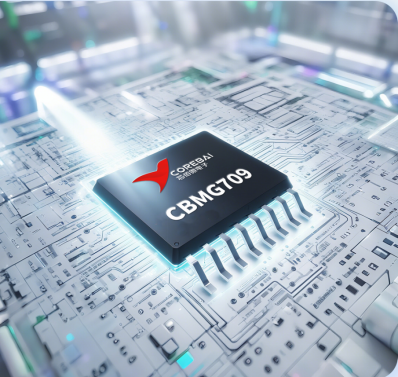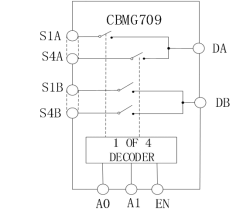 Released:2025-08-27 14:27:31
Released:2025-08-27 14:27:31 Views 639 次
Views 639 次 在工业控制、数据采集与通讯系统等场景中,差分信号因具备抗共模干扰、低传输损耗的优势,成为高精度信号传输的首选形式。芯佰微电子(Corebai)推出的 CBMG709 低压 CMOS 差分 4:1 多路复用器,凭借宽电源范围、低导通电阻、高速切换等特性,为差分信号的路由与切换提供了高可靠性解决方案。本文将从产品特性、引脚功能、电气性能、应用设计及订购信息等维度展开专业解析,为工程师选型与电路设计提供参考。
在工业控制、数据采集与通讯系统等场景中,差分信号因具备抗共模干扰、低传输损耗的优势,成为高精度信号传输的首选形式。芯佰微电子(Corebai)推出的 CBMG709 低压 CMOS 差分 4:1 多路复用器,凭借宽电源范围、低导通电阻、高速切换等特性,为差分信号的路由与切换提供了高可靠性解决方案。本文将从产品特性、引脚功能、电气性能、应用设计及订购信息等维度展开专业解析,为工程师选型与电路设计提供参考。

In industrial control, data acquisition, and communication systems, differential signals have become the preferred choice for high-precision signal transmission due to their advantages of resisting common-mode interference and low transmission loss. The CBMG709 Low-Voltage CMOS Differential 4:1 Multiplexer, developed by Corebai Microelectronics, offers a highly reliable solution for differential signal routing and switching through its wide power supply range, low on-resistance, and high-speed switching capabilities. This article provides a professional analysis covering product features, pin functions, electrical performance, application design, and ordering information, offering engineers valuable references for component selection and circuit design.

In the wave of industrial digital transformation and intelligentization of portable devices, differential signals, as a transmission method with stronger anti-interference capabilities, have become the core choice for multi-channel data acquisition, industrial control, and communication equipment. However, current engineering practices still face three critical challenges in differential signal processing: During synchronized multi-sensor collection in industrial environments, channel switching in traditional multiplexers often leads to over 12% data anomalies, while common-mode interference and signal distortion severely impact control accuracy; Portable devices struggle to balance high-speed signal switching requirements with low-power design goals under limited power consumption budgets, as traditional analog switches consume up to 2.5mW per channel – far exceeding battery-powered systems' tolerance limits; Meanwhile, mixed-use scenarios involving both legacy and new equipment present significant compatibility challenges due to protocol diversity and power architecture differences (1.8V-5V wide range). These pain points are particularly evident in industrial IoT sensor networks and portable measurement instruments, urgently requiring systematic solutions from high-performance differential multiplexers.
CBMG709 by Corebai is a multiplexer designed for differential signals. Its core features are based on "low voltage compatibility, low loss, high speed and high stability":

functional block diagram
1. Flexible power supply capability: Supports two power supply modes, single power supply range of 1.8V to 5.5V, dual power supply range of ±2.5V, can be used for battery-powered portable devices, but also meet the dual power signal requirements in industrial scenarios, covering most low-voltage electronic system power architecture.
2. Low On-Channel Resistance and Flatness: The typical on-resistance is only 3Ω, with a maximum of 4.5V (at VDD=5V), while maintaining a channel-to-channel flatness of 0.75Ω. This design significantly reduces signal attenuation during switching, making it particularly suitable for analog signals requiring high amplitude precision (e.g., sensor differential outputs) and effectively preventing measurement errors caused by resistance fluctuations.
3. Ultra-low leakage current and high-speed switching: The maximum leakage current is 100pA (typical value ±0.01nA), effectively preventing interference with downstream circuits even when channels are closed. Switching time (transmission time) typically measures 14ns (at VDD=5V), with a 8ns delay between de-energization and re-energization. The high-speed switching capability meets the requirements for high-frequency differential signals below 10MHz (such as baseband signals in communication systems), while the "de-energize-before-energize" design prevents transient short circuits during channel switching, protecting sensitive downstream components like ADCs.
4. Industrial-grade reliability and low power consumption: Operating within the standard industrial temperature range of-40℃ to +125℃, with storage temperatures spanning-65℃ to +150℃, it adapts to harsh industrial and outdoor environments. The typical quiescent current (I DD) is only 0.001μA, making it an ideal choice for battery-powered systems such as portable differential data acquisition devices due to its ultra-low power consumption characteristics.
5. Standardized packaging and compatibility: 16-pin TSSOP packaging, small package size and pin spacing specification, suitable for high-density PCB layout; digital input supports TTL/CMOS compatibility, no additional level conversion circuit is required to directly connect to the control signal of mainstream MCU or processor.

The 16-pin TSSOP package of CBMG709 has reasonable pin layout and concise control logic, which helps engineers to quickly realize circuit integration. Pin function definition and truth table logic:


In industrial automation, the CBMG709 serves as the core switching unit for multi-channel differential sensors. In industrial environments, critical parameters such as temperature, pressure, and flow rate are typically collected through differential signal sensors (e.g., the mV-level differential output of bridge-type pressure sensors). During long-distance transmission, these signals are susceptible to electromagnetic interference generated by equipment like motors and frequency converters. The CBMG709's 3Ω low on-resistance (at VDD=5V) minimizes signal attenuation, while its 0.75Ω flatness ensures full-range measurement linearity. Its industrial-grade temperature range of-40℃°C to +125℃°C enables stable operation in workshop environments with extreme temperatures. Within the PLC analog input module, four differential signals can be accessed via A0/A1 address lines through a time-sharing ADC access mechanism. The system employs a "de-energize-before-energize" switching design, featuring an 8ns delay mechanism that effectively prevents transient short circuits during signal transitions between different sensors, thereby ensuring the safety of downstream measurement circuits.
In industrial communication systems, the CBMG709 chip demonstrates exceptional performance in differential bus switching. Both the widely used RS485 and high-speed M-LVDS buses in industrial environments employ differential signal transmission. The chip's 14ns fast switching capability meets signal transmission demands up to 10MHz, which is particularly crucial for applications requiring data routing across multiple differential devices. In distributed communication node configurations, EN smart terminal control enables differential signal switching between a master station and four distinct slave stations. Its-60dB channel isolation at 10MHz effectively prevents crosstalk from unselected channels, ensuring data integrity. These features make it ideal for scenarios like smart buildings and industrial Ethernet networks that require multi-node differential communication.
When the application scenario does not involve differential signals, the same series of CBMG708 can be used as a cost-effective alternative:
1、The signal switching requirement is to switch from 8 single-ended signals to 1 common output, rather than a differential signal scenario. The target channel should be selected through 3-bit binary address lines (A0, A1, A2) (8 input channels correspond to S1~S8, and the common output is D);
2、The power supply architecture is consistent with CBMG709 (single power supply 1.8V~5.5V, dual power supply ±2.5V), and it needs to maintain low power consumption (static current at the same level), low on-resistance (typical value 3Ω) and compatibility with 16-pin TSSOP packaging, suitable for single-end signal processing scenarios such as data acquisition, audio and video switching;
3、For the 8-channel system requirements, without the ability to transmit differential signals, only single-ended signal multiplexing or demultiplexing functions are required, the 8:1 single channel design of CBMG708 is more suitable for such requirements than the 4:1 differential design of CBMG709.
010-62106066
( Monday to Friday 9:00 - 18:00 )
 704-705, Block D, Building 2, No. 9 Fenghao East Road, Haidian District, Beijing
704-705, Block D, Building 2, No. 9 Fenghao East Road, Haidian District, Beijing

Wechat Public Account